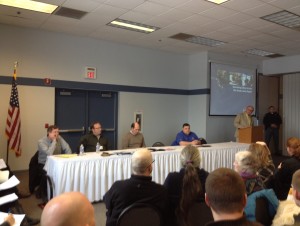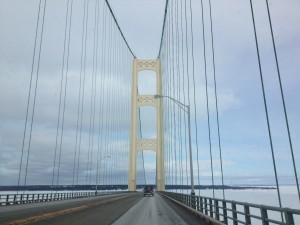

FLOW Executive Director Liz Kirkwood
FLOW and a number of organizations have come together over the last year to rally the public and raise awareness about the Canadian energy company Enbridge and their Line 5 pipeline, a 61-year-old pipeline under the Straits of Mackinac in the Great Lakes which has increased in flow and pipeline pressure and poses a great risk to our common water. On February 5, I carpooled up to St. Ignace, Michigan to attend a public meeting wherein Enbridge delivered a presentation to Mackinac County officials (and a packed room full of concerned citizens) to assuage growing concerns about the Line 5 pipeline expansion. My companions Jim Dulzo from Michigan Land Use Institute, FLOW intern Jonathan Aylward and I didn’t know what to expect, but we certainly all had a lot of questions that remained unanswered.
Background: The issue captured our attention after a critical 2012 report from National Wildlife Federation (NWF) titled Sunken Hazardpublished the scary facts: if Line 5 were to leak, then in the eight minutes that it takes for Enbridge to shut off the pipeline about 1.5 million gallons of oil would release, along with catastrophic impacts and dispersion across both Lakes Michigan and Huron. However, this is not even the “worse case discharge” given that it took the same company, Enbridge, 17 hours to respond to the worse inland oil pipeline spill in U.S. history along the Kalamazoo River just 3 years ago. In short, the Great Lakes have never been more at risk and yet the public is largely uninformed.
Why FLOW is concerned:
- We know that Enbridge has “upgraded” Line 5 with new pump stations but we don’t know for sure what “product” (light or heavy, sweet or sour, dilbit, etc) is being transported 640 miles from Superior, Wisconsin through the Straits of Mackinac to Sarnia, Ontario;
- Heavy tar sands is the dirtiest and most carbon-intensive energy on earth and a spill would destroy our shared international waters and way of life;
- This “upgraded” pipeline is 61-years-old and is submerged under water in the heart of the Great Lakes that contains 20 percent of the world’s fresh surface water;
- Enbridge has a dismal pipeline safety record, underscored by the two recent heavy tar sands disasters in Marshall, Michigan along the Kalamazoo River (1 million gallons spilled in 2010) and Grand Marsh, Wisconsin (50,000 gallons spilled in 2012);
- Federal pipeline regulations do not provide for public disclosure in the event of a product change from light crude oil to heavy crude oil for example; and
- An unsettling feeling of lack of transparency and public disclosure about the safety of Line 5 for the Great Lakes.
The Enbridge “side of the story”
At 2 pm at Little Bear Arena in St. Ignace, Mackinac County Planning Commission (“the Commission”) Chairman Dean Reid stood before 175 people, amazed at the turnout, and explained the rationale for this special meeting. The fact of the matter was that the Commission “wanted to hear Enbridge’s side of the story” after receiving NWF’s Sunken Hazard, and video footage of the submerged Line 5 under the Straits of Mackinac. Interestingly, though, I learned from Beth Wallace at NWF who co-authored the report that the Commission did not invite NWF to participate as a panelist to publically present both points of view.

Commission officials and the audience listen to the Enbridge representatives’ presentation.
Chairman Reid laid out the agenda, calling for Enbridge to address the integrity of their Line 5 pipeline under the Straits of Mackinac, the frequency of their testing, and emergency procedures in the event of a pipeline rupture. Recognizing the potential regional impact a spill would have in the Straits, the Commission invited other local units of government and organizations to attend this meeting. No public comments were allowed, but Enbridge panelists read and answer cards with written questions.
Next came Enbridge Community Relations Director Jackie Guthrie who described herself as a mom but also as a former lieutenant colonel in the U.S. Army. She gave the audience a succinct and compelling PR presentation on Enbridge’s overall operations. “Think of Enbridge as the ‘Fed-Ex’ of the oil and gas industry,” she cleverly described, “Enbridge delivers 2.5 billion barrels of crude and liquid petroleum, 5 billion cubic/feet of natural gas, and 1,600 MW of renewable energy a day.” Her numbers underscored the amazing recent growth of this billion-dollar company coinciding with North America’s energy boom. For example, in the last seven years, Enbridge had doubled its employees to 11,000. Guthrie concluded her overview by noting that Enbridge was recognized as one of the Global 100 Most Sustainable Corporations in the World.
This last claim got me thinking: if Enbridge can get that level of praise despite its shocking track record of 800 pipeline spills in the U.S. and Canada between 1999 and 2010, leaking 6.8 million gallons of oil and causing the largest inland heavy tar sands rupture in U.S. history, I wonder what the other energy companies are like.
Guthrie described the Line 5 as a 650-mile pipeline originating in Superior, Wisconsin traveling across the Upper Peninsula across the Straits of Michigan and down to Sarnia, Ontario. Line 5 is a 30-inch pipeline, except across the Straits where it divides into two 20-inch pipelines. Guthrie emphasized that Line 5 was carrying “light crude oil” which has “the consistency of skim milk.”

The view driving across the Mackinac Bridge: the Enbridge Line 5 oil pipeline is submerged beneath the same Straits of Mackinac that the Bridge traverses.
Blake Olson, Enbridge’s Escanaba Area Manager for over 400 miles of Line 5, followed with a presentation on the integrity of the Line 5 pipeline. He described Line 5 in the Straits as a one-inch thick seamless steel pipe, build with such a robust design that they just don’t build pipelines like this anymore. In fact, Olson commented that Line 5 at the Straits is the thickest pipeline in North America. Since 2012, Enbridge had increased the flow or volume of the product by 10 percent. Then he made the case that Enbridge had made a number of significant upgrades in their leak detection system within the last couple of years, including:
- automatic shut-off valves at both sides of the Straits,
- replacement of St. Ignace Valve Yard (2011) and Valve Yard containment system (2012),
- the on-going installation of emergence flow restriction devices,
- a back-up electric generator installed in 2013, and
- a thermally imaging leak detection system to be installed this year.
In addition, Olson described Enbridge’s integrity protective system along Line 5, which included corrosion prevention with coal tar coating and cathodic protection, anchor strike prevention and brackets every 50 feet (coming this summer), monitoring with internal and external pipeline inspections, lighted shore signage and nautical charts stating DO NOT ANCHOR.
Too little, too late?
This was an impressive list to the casual listener/observer, but what troubled me was that a lot of these basic safety protections to ensure pipeline protection were recently instituted and this pipeline was 61-years-old. For example, in the 61 years of this pipeline’s history, the U.S. Coast Guard did not have nautical charts informing vessels about the very location of Line 5 until January 2014. This change only happened because a number of concerned Michigan groups met with the Governor’s office to discuss Line 5’s safety in December 2013.
Olson assured the audience that Enbridge’s integrity program demonstrated that Line 5 under the Straits was “fit for service” with no dents or anomalies and met all federal pipeline regulations.
Before the Q&A session, Enbridge invited its contractor Bill Hazel from Marine Pollution Control to provide an overview of the emergency response measures set in place in the event of catastrophic spill on Line 5 under the Lakes. Hazel pointed to a number of simulated winter emergency response drills that Enbridge had participated in or serves as the lead in 2008, 2012, 2013, and this year. What became crystal clear was how catastrophic a Line 5 rupture would be especially during the wintertime. One follow-up question captured our imagination of this seemingly impossible mission: ‘May day, May day, May day! It’s January 21, 2014 and it’s -9 °F and the wind chill is -25 °F, the Straits of Mackinac are frozen over, the ice four feet deep, and Line 5 has ruptured under the ice. What are you going to do about it?’

Left to right: Jim Dulzo, MLUI; Jonathan Aylward, FLOW; Lee Sprague, Little River Band of Ottawa Indians; Anne Zukowski, Don’t Frack Michigan; Jannan Cornstalk, Little River Band of Ottawa Indians
Enbridge answers (some) public questions
Following a final word from the local emergency manager in Mackinac, Guthrie gathered the 5×7 questions cards, proceeded to sort them into piles, and distributed them to the appropriate Enbridge representative for answers at the podium. Several illuminating points came out:
- Line 5 only transports light crude oil, the consistency of skim milk.
- Line 5’s light crude oil currently comes the Bakken oil fields.
- There are no plans to pump heavy crude oil through Line 5.
- Seamless pipe wasn’t really a seamless pipe as Enbridge had described previously, rather Line 5’s two 20-inch pipelines are seamless only up to the joints that repeat every 40 feet along the 4-mile stretch along the bottomlands of the Straits.
- A wintertime spill would present unprecedented challenges in mounting an emergency response.
- If a rupture occurred and the automatic shut-off valves turned off in a 3-minute period, 5,500 barrels would be released and disperse over an area 25-square-miles wide. This number was down considerably from 15,000 barrels before Enbridge installed the automatic shut-off valves.
The last question was: ‘If tar sands were being transported through Line 5, what pipeline changes would Enbridge have to make?’ Enbridge’s Guthrie pulled the card aside and said, “let me hold off on this question because it is complex.” But time was on Guthrie’s side as the meeting ended sharply at 3:30 pm and she never had to answer this telling question.
The composed Midwestern temperament of the room quickly changed as audience members shouted out that their questions had not been answered. But it was clear that the meeting was over.
The bottom line for the bottomlands
I walked out into the 12 °F air, looked out over the Straits and felt an urgent need for additional public forums in Mackinac and the Great Lakes to further educate and inform all walks of life who live here about Line 5. Enbridge had attempted to calm the public’s concerns about Line 5, but they hadn’t been entirely forthright and it bothered me. Without public transparency, we will need to engage the State of Michigan to assert its authority as trustee of the waters and bottomlands of the Great Lakes for the benefit of the public.
What I’m talking about is the public trust doctrine, which legally requires Governor Snyder and both the Department of Natural Resources and the Department of Environmental Quality, as state trustees, to ensure that Enbridge’s Line 5 under the Straits will not impair the public waters of the Great Lakes. This means that the State must demand full transparency and disclosure of all Enbridge’s activities not only for the people within range of a potential catastrophic spill, but for all residents of Michigan. Thus, if and when Enbridge decided to transport any type of heavy tar sands oil through Line 5, Enbridge has a duty to inform the state and the public and secure proper authorization under the Great Lands Submerged Lands Act. That’s FLOW’s take on the issue, and it’s what you will be hearing more about in the weeks and months to come. Stay tuned.

An oil spill under the straits of Mackinac would be much more serious than an oil spill in the Atlantic or Pacific. Except for Lake Superior, the oil could then contaminate four of our freshwater Great Lakes and their connecting waters and the life in and around them. Read more about this in my book, The Dynamic Great Lakes.
I was concerned about the actual composition of the product going through the pipes. They made the comment that pressure is less, even though the volume going through the pipes is more. Surfactants and Drag inhibitors are toxic in small amounts.
This is an important issue and a very well done account. Nice work. Keith
Good luck with Public Trust Doctrine, and Navigation Servitude trumping that on Enbridge Line #5 ….
As with uncompensated accelerated outflow of our Michigan water resource thru Lake M/H via the St Clair River (from commercial ship dredgings) …. Governor Snyder and his chimps DNR Director Kreagh, and DEQ Submerged Lands Chief Tom Graf will not protect our water resource for future generations enjoyment … it’s too political for them !!!
They certainly are not behaving like trustees. What the state is not doing to protect our water resource is criminal, and morally reprehensible.
there must be a way to enforce the responsibilities of the trustees – even in the cases of otherwise unemployable treasonists who occupy public office, are bound by oaths of office, by duty-of-care obligations, and yet aid and abet harmful agendas for parties known and unknown and extend themselves the protections of immunity, secrecy, selective discrimination, misappropriation
there must be lawyers who have transcended allegiance to the clique, who have both the expertise to navigate the byzantine legislative scribblings, the integrity to pursue the presumption of lawful and honourable intention underlying the codes, and the temerity to ensure that exposure of the frauds and enforcement of the lawful consequences is executed
Good to note how Enbridge has responded to public concern in a relatively short time period. Encourages public to keep at it- education and awareness at heart of it- Lets keep sharing this information with all who like swimming in the great lakes and eating fish. Astonishing that Enbridge has sustainability award… what kind of sustain-ing-ability? Keep up the good work FLOW!
This terrifies me.
Do not understand why this info is not blasted out on state TV channels and on front pages of newspapers. Why is it being kept so quiet? I called a lot of gov offices today and only Stabenow’s office said that they had knowledge of it.
Thank you. I deeply appreciate your pursuit and writing on this important situation. I will start an Avaaz petition in Ontario if you can help me with setting it up. We have a new Liberal majority government under Kathleen Wynne. and she may show some strength and courage. She has her chance now to be a champion for what is truly the good of the nation.
Informative story, Liz. Thank you.
Great article, Liz K. I must say, here in Wisconsin, one year later, we may be just waking up (like hibernating bears)to the fact that Enbridge lies, destroys water, continues to claim that pipeline expansion is safe and pretends to tell the truth about what’s being shipped through pipelines that are laid underground and worse under the Great Lakes.
Here’s a telling comment from PM,
a Michigan resident on this blog http://grangehallpress.com/Enbridgeblog/2015/02/04/no-rover-vector-expansions-for-now/
re: Enbridge Line 6B
“February 5, 2015
To clarify: Enbridge knew I was going to fight very hard against line 6B and they thus sent us a letter that they intended to stay off our property. This made it harder as we were no longer stakeholders. As soon as they got their go ahead, they said they changed their intent, were going to build the pipeline on our property, and laughed about it. “Intent has no legal meaning.” “Plans changed.” This is a game they play so everyone needs to stay vigilant.
It’s a problem for everyone in the state, the country, and even the world. I make this clear when I give talks about the Marshall spill and its aftermath and how we need to work to change the laws. It’s important to hold these companies to much higher standards….”
I live in Cheboygan and in Straits Area Concerned Citizens for Peace,Justice and the Environment. We haven’t heard what people are doing for the Gov mtg the 24th. Is there any action or work being done? Your article here was outstanding as I was there. Your last article was in Cheb Trib and great. Thanks
Someone should ask them the specific questions: 1) How does one get an on line inspection tool ( Smart PIG) into the Straits xing when there is NO launcher barrel pointed to the crossing? 2) How was seamless longitudal pipe available in 1953 before the process was commercially available? 3) Where is the x-ray record from the Lakehead system for the xing? 4) Was the coating actually coal tar?
Liz and John,
Quick answers.
1. There appear to be two 20” pig launchers and one 30” pig receiver in St. Ignace.
2. Seamless pipe was first produced by the Mannesman brothers in 1880. See attached document on pipe production processes.
3. X Ray work on Line 5 was done by the famous Pittsburgh Testing Laboratory. Now defunct.
4. The coating question is a good one. The Straits easement and the MPSC 1953 order both say asphalt but Enbridge says coal tar. Based on best practice at the time
I believe it was coal tar with a fiberglas wrap and an overwrap of either asbestos felt or more fiberglas.
The quotes below are clipped from one of my PowerPoint slides.
1953 Easement Restrictions Regarding Corrosion Protection
(8) Cathodic protection shall be installed to prevent deterioration of the pipe
(9) All pipe shall be protected by asphalt primer coat, by inner wrap and outer wrap composed of
glass fiber fabric material and one inch by four inch (1” x 4”) slats prior to installation.
“Engineering and Construction Considerations for the Mackinac Pipeline Company’s Crossing of the
Straits of Mackinac” submitted by Mackinac Pipeline Company/Lakehead Pipeline Company
to the Michigan Department of Conservation, January, 1953
“After coating with asphalt primer, fiberglass inner wrap and an asbestos felt outer wrap, and after attaching
1” x 4” wood slats to the full circumference of the pipe, it will be lowered onto a previously prepared “bed”
on the floor of the Straits.”
A most important question concerns the slats or lagging used to protect the coating system from abrasion.
In the below picture I believe the NWF mis -identified the “broken supports’, they are really rusted out circumferential straps used to hold the lagging in place.
Also shown is a jpg of a pipe with lagging for protection taken from my presentation.
Finally an Enbridge underwater pic that I believe shows detached lagging.
Regards,
Ed